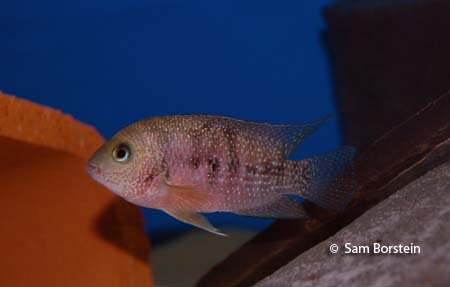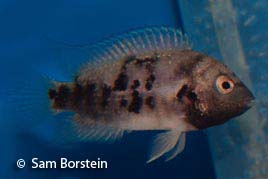Cryptoheros panamensis
(Meek & Hildebrand, 1913)
The Panama Cichlid
Synonyms: Archocentrus panamensis, Cichlasoma panamensis, Neetroplus panamensis

Above: A male C. panamensis. Photo by Sam Borstein.
Meaning of Name:
Genus- crypto= refers to breeding habits of fish (Greek), heros= original type genus, hero (Greek).
Species- panamensis= from Panama.
Intro:
Cryptoheros panamensis is a very pretty, small growing C. American, endemic to Panama. This fish, typed by Meek and Hildebrand in 1913 is not the most popular member of Cryptoheros, but is definitely one of the more colorful and aggressive species.
This fish has been thrown around when it comes to phylogenetics. It was thought to be a member on Neetroplus for a while, but after looking at teeth and jaw structure, it was moved to Archocentrus, and then to Cryptoheros by Allgayer in 2001. It remains in Cryptoheros even after the Schmitter-Soto paper, but is now in a monotypic sub-species Panamius. It is debated by some taxonomists if the genus Cryptoheros is valid or not.
Distribution:
Cryptoheros panamensis is only found in Panama.
Size, Maturity, and Sexual Dimorphism:
Size: Males- 4.5 inches, Females- 4 inchesMaturity: 1 inch
Sexual Dimorphism: Males are larger than females, and attain trailers to the anal and dorsal fin. Females also take on a black and white breeding dress.
Care:
Cryptoheros panamensis is an easy fish to keep. They are extremely aggressive for a member of their genus, so a large tank is needed. C. panamensis seems to be only very aggressive within its own species, but will go after other fish. If you want to keep them with something, look for a fast fish that can take a beating. Aggression between individuals, especially males is extreme, and they will eventually whittle down to a pair. I've heard males can be rough on females. This was not my experience.
C. panamensis is a hearty fish, and really needs no special treatment. They do great if you can do water changes once a week. Their color will show more, and in my experience, be more likely to spawn.
Diet:
Cryptoheros panamensis is an omnivore, and will accept almost any food offered.
Breeding:
C. panamensis is easy to breed. They will breed young and small, my female was about an inch, my male 1.5 inches when they first bred the female was only an inch! These fish once started, won't stop. If I pulled eggs or fry my pair would spawn again within 10 days.
Before spawning, the female changes color drastically. Instead of having the mottled red color, they turn a mottled black and white. The change reminded me of both Neetroplus neematopus, and Hericthys carpintis.

Above: A female Cryptoheros panamensis in breeding color. Photo by Sam Borstein.
C. panamensis make great parents. Of course, like most other cichlids, the first spawn may fail, which was my case, but after that, they were marvelous parents. Like many Central Americans, the female stays over and fans the spawn, while the male defends the territory. In C. panamensis, my experience is that the female does all the work. She is relentless towards any other fish, even the male. She had all the other fish in a 3 foot tank pinned in the corners, except for the male, who was on the other side. Once free swimming, the female allowed the male into the male in the territory. Together they raised the fry for about 1 month until I pulled the fry.
Fry are easy to raise and grow quickly. They do great at first on baby brine shrimp, and then on crushed flake.
Conclusion:
C. panamensis is one of my favorite Centrals. They are nasty, pretty, and easy to keep. If you like members of the convict like fishes, you will love these guys. I do recommend keeping an easier species similar to convicts first, because these can be difficult to deal with. Don't expect to find these at a pet shop. These fish are available from hobbyists though and are relatively inexpensive.
References:
-
Schmitter-Soto, J.J., 2007. A Systematic Revision of the Genus Archocentrus (Perciformes:Cichlidae), with the Description of Two New Genera and Six New Species. Zootaxa 1603: 1-76.
